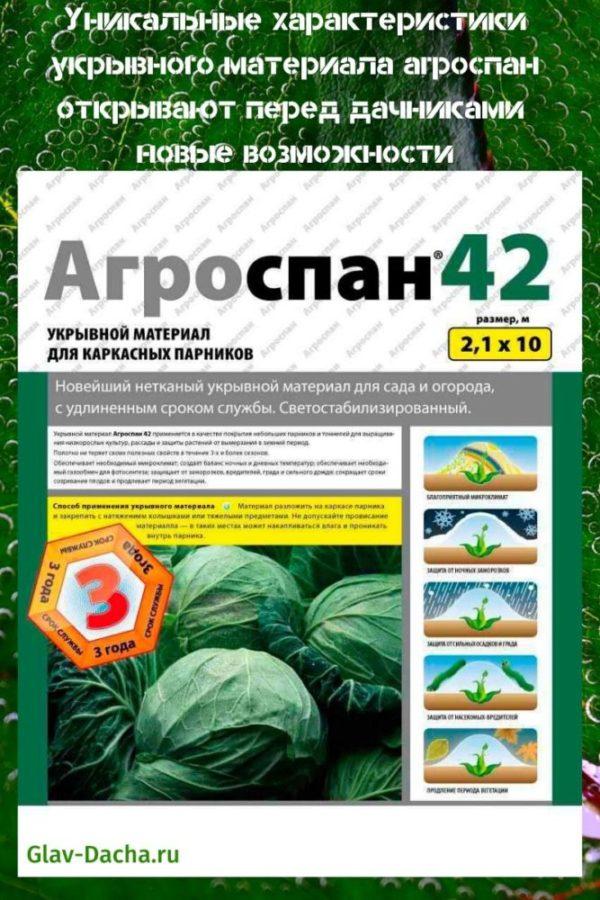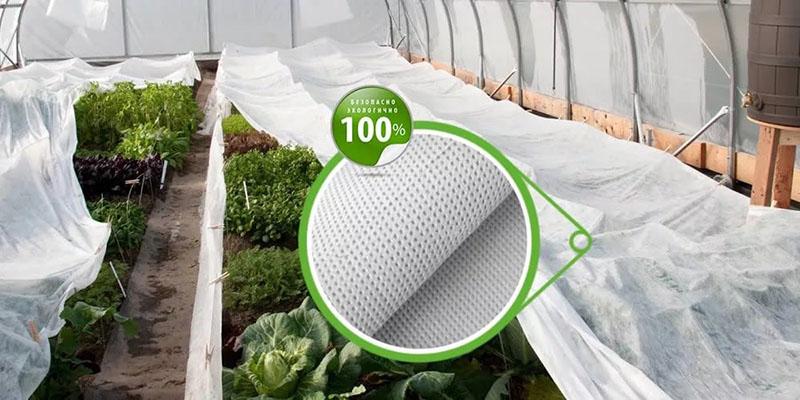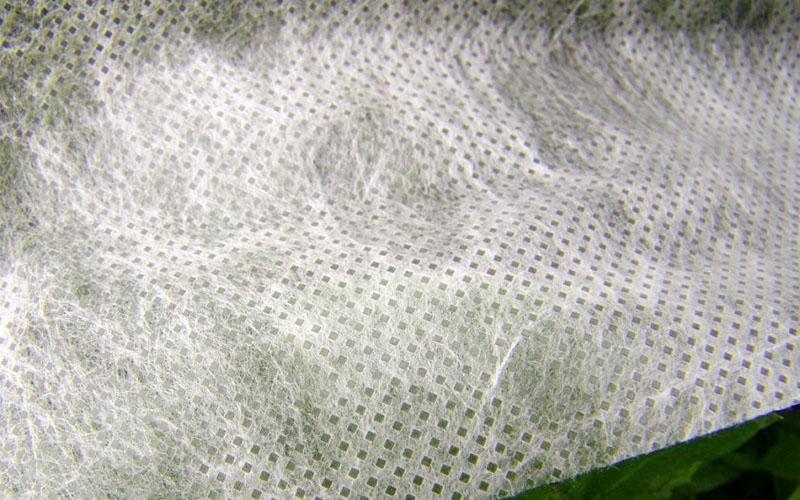The unique characteristics of Agrospan covering material open up new opportunities for summer residents
 Spring frosts are fraught with a latent danger to crops, as they can destroy the entire planting in one night. Having considered the main characteristics of Agrospan covering material, many have found a unique application for nonwoven fabric in various fields of agriculture. The product is used in the construction of greenhouses, as a protective barrier in cold and hot weather. The main purpose of synthetic fabric is to create a suitable microclimate for growing crops.
Spring frosts are fraught with a latent danger to crops, as they can destroy the entire planting in one night. Having considered the main characteristics of Agrospan covering material, many have found a unique application for nonwoven fabric in various fields of agriculture. The product is used in the construction of greenhouses, as a protective barrier in cold and hot weather. The main purpose of synthetic fabric is to create a suitable microclimate for growing crops.
The main characteristics of the covering material Agrospan

What it is can be understood with a detailed examination of its physicochemical features:
- high air and moisture permeability;
- resistance to atmospheric and temperature changes;
- unique strength (does not break under loads);
- environmental friendliness (prevents the occurrence of mold and rot);
- special wear resistance (not wrinkled or abraded).
Agrospan contains high quality UV-stabilizers of the Agrolight series. These components prevent the fibers from scattering for several seasons, especially when used in high mountain areas.
 The use of agrotextile enables the farmer to control the climatic conditions when growing agricultural plants. Under cover, young seedlings are fully nourished and grow. One of the essential characteristics of the covering material Agrospan is the ability to protect the planting from hypothermia at night and unwanted overheating during the day. At the same time, agrofibre does not allow moisture to completely evaporate from the soil surface. This way, the required amount of liquid is retained in the soil, and farmers can save on watering.
The use of agrotextile enables the farmer to control the climatic conditions when growing agricultural plants. Under cover, young seedlings are fully nourished and grow. One of the essential characteristics of the covering material Agrospan is the ability to protect the planting from hypothermia at night and unwanted overheating during the day. At the same time, agrofibre does not allow moisture to completely evaporate from the soil surface. This way, the required amount of liquid is retained in the soil, and farmers can save on watering.
In addition, the covering material prevents the appearance:
- insect pests;
- diseases;
- weeds.
Thanks to the polymer canvas, some summer residents can harvest bountiful harvests until late autumn.
 In most cases, manufacturers indicate the optimal shelf life of the product, which is 3 seasons. However, this indicator largely depends on the brand and density of the fabric. The presence of stabilizers that protect against ultraviolet radiation extends the service life up to 5 years. The use of Agrospan reduces labor costs of farmers by almost 5 times and increases the yield of agricultural crops by 20%.
In most cases, manufacturers indicate the optimal shelf life of the product, which is 3 seasons. However, this indicator largely depends on the brand and density of the fabric. The presence of stabilizers that protect against ultraviolet radiation extends the service life up to 5 years. The use of Agrospan reduces labor costs of farmers by almost 5 times and increases the yield of agricultural crops by 20%.
Classification from leading manufacturers
 Recent studies in the field of the influence of the spectrum of light waves on plant growth have shown interesting results. The yellow color contributes to the complete disorientation of insect pests. This reduces the cost of insecticidal products. Red tones ensure fast ripening of fruits and are actively involved in the processes of photosynthesis. For this reason, many companies began to produce covering material in different colors. Nevertheless, manufacturers focus on the density of agrofibre.
Recent studies in the field of the influence of the spectrum of light waves on plant growth have shown interesting results. The yellow color contributes to the complete disorientation of insect pests. This reduces the cost of insecticidal products. Red tones ensure fast ripening of fruits and are actively involved in the processes of photosynthesis. For this reason, many companies began to produce covering material in different colors. Nevertheless, manufacturers focus on the density of agrofibre.
There are 3 categories in this classification:
- Marking 17-30. Use directly on the garden bed. Agro-fabric completely covers sowing areas or seedlings. The canvas is laid in the garden without tension. The edges are fixed with special devices or pressed with heavy objects / sprinkled with earth.
- Brand 42-60 (90-110). It is used instead of conventional film as a covering material for greenhouses / greenhouses and similar structures.

- Double-sided, red, yellow and black Agrospan. It contains UV stabilizers and carbon black for darkening. It is in demand for mulching technique. The dark shade of the canvas absorbs the maximum amount of heat, thereby warming up the area. Weeds and their seeds do not receive enough light, which leads to their death.

The degree of frost protection depends on the density of the agrotextile. The higher this indicator, the lower the throughput. Basically, the non-woven fabric protects the fit from a drop in temperature down to -4 ° C.
 The mulching cloth is pulled over the landing by cutting out the cruciform holes. It is not removed until harvesting. The technical characteristics of agrospana allow the gardener to water the beds, as well as apply fertilizers on time. For the cultivation of perennial berry crops, the polymer material is used on an ongoing basis, never removing it.
The mulching cloth is pulled over the landing by cutting out the cruciform holes. It is not removed until harvesting. The technical characteristics of agrospana allow the gardener to water the beds, as well as apply fertilizers on time. For the cultivation of perennial berry crops, the polymer material is used on an ongoing basis, never removing it.
Application features
 Agro-fabric is in wide demand not only among ordinary summer residents, but also among large farmers. Non-woven fabric is used to cover large areas of land, entire fields. The low cost of the material allows you to reliably protect the land from the negative effects of weather conditions.
Agro-fabric is in wide demand not only among ordinary summer residents, but also among large farmers. Non-woven fabric is used to cover large areas of land, entire fields. The low cost of the material allows you to reliably protect the land from the negative effects of weather conditions.
Synthetic fiber is used:
- in spring from night frosts;
- in summer to stabilize the temperature regime and prevent overheating;
- in the fall to extend the harvest;
- in winter to protect against harsh climatic conditions.
Colonies often appear under the black mulching agrospan ants... Then the bed is watered with a solution of ammonia (1 tbsp. L. Per 8 l of liquid). For culture, the suspension serves as a top dressing, and for insects - an insecticide.
 The most common mistake when choosing a covering material is the wrong density. For covering the first shoots, agrotextiles of grade 17 or 30 are best suited. It is relevant when there is a threat of small temperature drops. The translucent texture does not obstruct the passage of sunlight. In addition, the necessary air exchange is maintained, which prevents the appearance of delights.
The most common mistake when choosing a covering material is the wrong density. For covering the first shoots, agrotextiles of grade 17 or 30 are best suited. It is relevant when there is a threat of small temperature drops. The translucent texture does not obstruct the passage of sunlight. In addition, the necessary air exchange is maintained, which prevents the appearance of delights.
Installation work
 Despite all the characteristics of the Agrospan covering material, the installation of the canvas is carried out extremely carefully. Fibers that are too thin will break on contact with sharp objects.
Despite all the characteristics of the Agrospan covering material, the installation of the canvas is carried out extremely carefully. Fibers that are too thin will break on contact with sharp objects.
Polymer fabric is fixed to the surface:
- nails;
- staples (furniture stapler);
- self-tapping screws.
 Wooden slats or rubber gaskets are placed under the fasteners. In the case of using a denser agrotextile, clamping wire pins are used. To attach the material to a tunnel greenhouse with arcs, plastic clips or ordinary clothespins will come to the rescue.
Wooden slats or rubber gaskets are placed under the fasteners. In the case of using a denser agrotextile, clamping wire pins are used. To attach the material to a tunnel greenhouse with arcs, plastic clips or ordinary clothespins will come to the rescue. 
Proper care of Agrospan. Polymer fabric has been used for several seasons. Therefore, it must be disinfected in a weak solution of potassium permanganate or treated with a fungicide. This procedure reduces the risk of contamination of crops with fungal diseases.
Ornamental shrubs and trees are usually wrapped with Agrospan for wintering with marking 42 or 60. This should be done for regions where the probability of a snowy winter is very low. A synthetic fabric is wrapped, like a bandage, around the crown and fixed with twine. Some gardeners specially sew covers that are semi-loosely attached to the plant.Compliance with the recommendations given will help the summer resident to protect his landing as much as possible from the effects of abnormal phenomena.